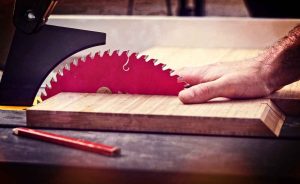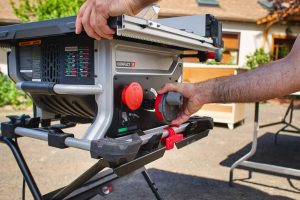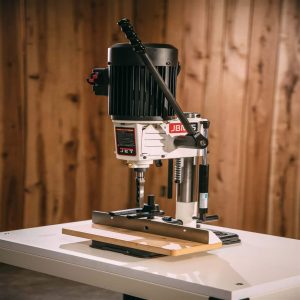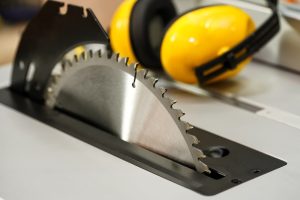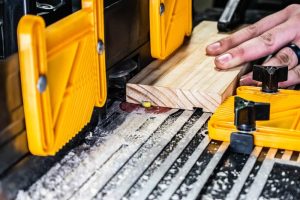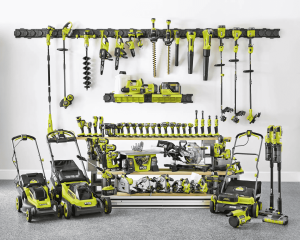If you’re a woodworking enthusiast or professional, you know that precision is everything. One of the most versatile yet underutilized tools in your workshop is the miter gauge for your table saw. Mastering how to use a miter gauge on a table saw can dramatically improve the quality of your projects, enabling you to create perfectly angled cuts with confidence and accuracy.
A miter gauge is a simple but ingenious device that slides in the table saw’s miter slot, allowing you to guide workpieces through the blade at various angles. Whether you’re building picture frames, constructing furniture with angled joints, or creating decorative pieces, understanding how to properly use this tool is essential.
In this comprehensive guide, we’ll walk you through everything you need to know about how to use a miter gauge on a table saw, from basic setup to advanced techniques. By the end, you’ll have the knowledge and confidence to tackle any angled cutting project that comes your way.
How to Use a Miter Gauge on a Table Saw
Before diving into techniques, it’s important to understand what a miter gauge is and its components.
What Is a Miter Gauge?
A miter gauge is a guiding device used with table saws to make accurate crosscuts and angled cuts. It consists of a head that can be rotated to different angles and a metal bar that fits into the miter slots on your table saw. The head typically has a protractor scale with degree markings to help you set precise angles.
Parts of a Miter Gauge
Most miter gauges have these key components:
- Bar: The metal portion that slides in the miter slot of your table saw.
- Head: The portion that holds the workpiece and can be adjusted to different angles.
- Face Fence: The vertical surface against which you place your workpiece.
- Angle Scale: Markings indicating degrees (usually from 0° to 60° on both sides).
- Locking Mechanism: A knob or lever that secures the head at your desired angle.
- Extension Wings (on premium models): Adjustable fences that provide more support for larger workpieces.
Types of Miter Gauges
Not all miter gauges are created equal. There are generally two types:
- Basic Miter Gauges: These come standard with most table saws. They’re functional but may lack precision and features of aftermarket options.
- Premium Miter Gauges: Aftermarket options like the Incra Miter Gauge or Osborne EB-3 offer enhanced accuracy, better construction, and additional features like positive stops at common angles.
Safety First: Preparing to Use Your Miter Gauge
Before making any cuts, safety should be your top priority. Table saws are powerful tools that can cause serious injury if used improperly.
Essential Safety Equipment
Always wear:
- Safety glasses or goggles.
- Hearing protection.
- Dust mask (especially when cutting certain materials).
- Appropriate clothing (no loose sleeves or jewelry).
Table Saw Safety Considerations
- Ensure your table saw is properly set up and maintained.
- Check that the blade is sharp and properly aligned.
- Use the blade guard when appropriate (though you may need to remove it for some miter gauge operations).
- Never reach over a moving blade.
- Use a push stick when necessary to keep your hands away from the blade.
- Disconnect power when changing blades or performing maintenance.
Workspace Setup
- Clear your work area of unnecessary tools and materials.
- Ensure good lighting.
- Have adequate space to support long workpieces.
- Check that your miter gauge slides smoothly in the miter slot without excessive play.
Setting Up Your Miter Gauge
Proper setup is crucial for achieving accurate cuts with your miter gauge. Follow these steps to ensure your gauge is ready for use.
Checking for Square
Before making any angled cuts, you need to verify that your miter gauge is perfectly square (90°) to the blade:
- Place the miter gauge in the miter slot with the head set to 0°.
- Use a reliable square to check the relationship between the miter gauge face and the saw blade.
- If it’s not square, adjust the miter gauge according to the manufacturer’s instructions. Some models have set screws that allow for fine-tuning.
Calibrating the Angle Indicators
The built-in angle scales on many miter gauges aren’t always perfectly accurate. To calibrate yours:
- Set the gauge to a common angle like 45° using a reliable drafting triangle or digital angle finder.
- Note where the indicator points on the scale compared to the actual angle.
- Make a mental note or physical mark of any discrepancy, or adjust the scale if possible.
Adjusting for Accuracy
For the best results:
- Ensure the bar fits snugly in the miter slot without binding. Some aftermarket gauges have adjustable washers to eliminate play.
- Check that the face fence is flat and true.
- Verify that any extension wings are properly secured and square to the fence.
Attaching and Securing Workpieces
To hold your workpiece securely:
- Use the clamp that came with your miter gauge if available.
- For longer pieces, consider adding an auxiliary fence to the miter gauge.
- Ensure the workpiece is flat against the fence and won’t shift during the cut.
Basic Miter Gauge Techniques
With your miter gauge properly set up, you’re ready to start making cuts. Let’s begin with the fundamentals.
Making 90-Degree Crosscuts
The most basic cut you’ll make with a miter gauge is a 90-degree crosscut:
- Set your miter gauge to 0° (or 90°, depending on how your gauge is marked).
- Place your workpiece against the face fence, ensuring it’s flat and secure.
- Hold the workpiece firmly against the fence with one hand.
- With the other hand, grasp the miter gauge handle.
- Turn on the saw and let it reach full speed.
- Smoothly and steadily push the miter gauge and workpiece through the blade.
- Continue pushing past the blade until the cut is complete.
- Turn off the saw and wait for the blade to stop completely before retrieving your piece.
Creating Basic Miter Angles
Making angled cuts follows the same process but requires careful angle setting:
- Loosen the locking mechanism on your miter gauge.
- Rotate the head to your desired angle (for example, 45°).
- Lock the head in place.
- Double-check the angle with a reliable measuring tool.
- Position your workpiece against the fence.
- Make the cut following the same procedure as for a 90-degree cut.
For picture frames and other projects requiring complementary angles (like two 45° cuts that form a 90° corner), consistency is key. Set your angle carefully and make all identical cuts without changing the setting.
Techniques for Different Materials
Different materials may require adjustments to your technique:
For solid wood:
- Pay attention to grain direction to minimize tearout.
- Use a slower feed rate for dense or figured woods.
- Consider using a zero-clearance insert for cleaner cuts.
For plywood and sheet goods:
- Support the material well to prevent splintering.
- Use masking tape along the cut line to reduce chip-out.
- A sharp blade with a high tooth count works best.
For plastic or acrylic materials:
- Use a blade designed for plastics.
- Maintain a consistent feed rate to prevent melting.
- Leave the protective film on during cutting if possible.
Advanced Miter Gauge Operations
Once you’ve mastered the basics, you can move on to more complex operations with your miter gauge.
Compound Angles
Some projects require cuts that are angled both horizontally (miter) and vertically (bevel). This is known as a compound angle:
- Set your miter gauge to the horizontal angle.
- Tilt your table saw blade to the required vertical angle.
- Make test cuts in scrap material to verify the angle.
- Once confirmed, make your cuts in the actual workpiece.
Compound angles are common in projects like tapered columns or complex geometric shapes.
Creating Multiple Identical Pieces
When you need multiple pieces with identical angles:
- Create a stop block that clamps to your miter gauge fence.
- Set the stop block to the desired length from the blade.
- Cut your first piece.
- For subsequent pieces, simply place the workpiece against the stop block and cut.
- This ensures all pieces are the same length and angle.
Jigs and Accessories for the Miter Gauge
Enhance your miter gauge’s capabilities with these helpful additions:
Auxiliary Fence:
- Attach a wooden fence to your miter gauge for longer workpieces.
- Allows for better support and the ability to add stops or hold-downs.
Hold-Down Clamps:
- Keep your hands safely away from the blade.
- Prevent workpiece movement during cutting.
Sleds:
- A crosscut sled provides more stability than a standard miter gauge.
- Great for wider pieces and repetitive cuts.
Common Problems and Solutions
Even experienced woodworkers encounter issues when using a miter gauge. Here’s how to address common problems:
Dealing with Tearout
Tearout occurs when the wood fibers splinter as the blade exits the cut. To prevent it:
- Use a sharp blade with the appropriate tooth count.
- Score the cut line with a utility knife before sawing.
- Apply masking tape along the cut line.
- Use a zero-clearance insert.
- For expensive wood, consider a “backer board” – a scrap piece that supports the fibers as the blade exits.
Correcting Inaccurate Angles
If your cuts aren’t at the intended angle:
- Verify your miter gauge is properly calibrated.
- Check for play in the miter slot and adjust if necessary.
- Ensure your workpiece is held firmly against the fence.
- Make test cuts in scrap material and adjust accordingly.
Troubleshooting Common Issues
Binding in the miter slot:
- Clean the slot and gauge bar of dust and debris.
- Check for damage or burrs on either component.
- Apply a thin coat of wax to the bar for smoother sliding.
Inconsistent cuts:
- Ensure your workpiece is secured the same way each time.
- Check that your miter gauge is locking securely at the set angle.
- Verify that your technique is consistent, especially the feed rate.
Difficulty with longer pieces:
- Add an auxiliary fence for better support.
- Use roller stands or outfeed tables to support the workpiece.
- Consider building a dedicated crosscut sled for longer materials.
Maintenance and Care
Proper maintenance of your miter gauge will ensure years of accurate performance.
Cleaning and Lubricating
- Regularly remove dust and debris from the bar and head.
- Use a dry cloth or brush to clean the angle scale.
- Apply a small amount of dry lubricant (like paste wax) to the bar, avoiding oils that can attract dust.
Storage Recommendations
- Store your miter gauge in a dry place to prevent rust.
- If possible, hang it or keep it in a way that won’t damage the bar or scale.
- Consider keeping it in the miter slot if you use it frequently.
When to Replace Parts
- If the bar becomes bent or warped, it should be replaced.
- If the locking mechanism no longer holds securely, check for worn parts that may need replacement.
- If the angle scale becomes unreadable, some manufacturers offer replacement parts.
Expert Tips and Tricks
Take your miter gauge skills to the next level with these professional techniques:
Enhancing Accuracy
- Create a “perfect 90” reference block by cutting a piece of plywood with your well-calibrated miter gauge.
- Use digital angle finders for precise angle settings.
- Mark the center of your blade on the table saw surface for easy alignment.
Time-Saving Methods
- Set up dedicated jigs for common angles you use frequently.
- Create a story stick for repeated measurements.
- Group similar operations together to minimize setup changes.
Professional Techniques
- For extremely precise work, consider a high-quality aftermarket miter gauge with positive stops.
- Learn to “sneak up” on a cut by making multiple passes, removing small amounts each time.
- Practice cutting techniques specific to your projects – what works for framing may not be ideal for furniture making.
Conclusion
Mastering how to use a miter gauge on a table saw opens up a world of possibilities in your woodworking projects. From simple crosscuts to complex compound angles, this versatile tool is essential for anyone serious about woodworking.
Remember that practice makes perfect. Start with basic cuts in scrap wood before moving on to project materials. Always prioritize safety, and don’t rush the setup process – accuracy begins long before you turn on the saw.
With the techniques and knowledge outlined in this guide, you’re well-equipped to make precise, clean cuts with your miter gauge. Whether you’re building furniture, crafting frames, or creating decorative pieces, the confidence that comes with mastering this tool will elevate the quality of all your woodworking projects.
Happy woodworking, and always remember to measure twice, cut once!
